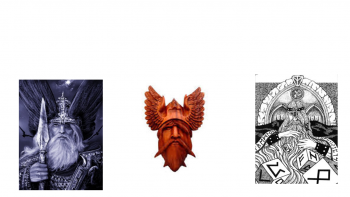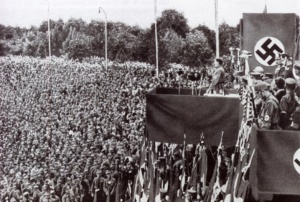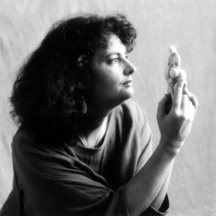Egregore
ARTICLE BEING REVISED
ARTICLE BEING REVISED
An egregore (pronounced egg’ gree gore) is a group thought-form. It can be created either intentionally or unintentionally, and becomes anautonomous entity with the power to influence. A group with a common purpose like a family, a club, a political party, a church, or a country can create an egregore, for better or worse depending upon the type of thought that created it.
The Theosophical Viewpoint
The concept was discussed in early Theosophical literature and is well-known in esoteric thought, but it is not a mainstream idea. In discussing egregores Helena Petrovna Blavatsky wrote “every thought so evolved with energy from the brain, creates nolens volens [willingly or unwillingly] a shape.” Continuing, she states that such a shape is absolutely “unconscious unless it is the creation of an adept, who has a pre-conceived object in giving it [the thought form] consciousness, or rather the appearance of consciousness derived from the adept’s will and consciousness."[1]
Theosophists first brought the idea of a thought-form to the public mind with Annie Besant and C. W. Leadbeater’s book Thought Forms in the early twentieth century.
Other Definitions
In his article "Understanding the Occult: What is an Egregore," Theron Dunn offers four more definitions –
- “An energized astral form produced consciously or unconsciously by human agency. In particular, (a) a strongly characterized form, usually an archetypal image, produced by the imaginative and emotional energies of a religious or magical group collectively, or (b) an astral shape of any kind, deliberately formulated by a magician to carry a specific force."[2]
- "from a Greek word meaning “watcher” - a thought-form created by will and visualization. A group egregore is the distinctive energy of a specific group of magicians who are working together, creating and building the same thought-form or energy-form."[3]
- "Any symbolic pattern that has served as a focus for human emotion and energy will build up an egregore of its own over time, and the more energy that is put into such a pattern, the more potent the egregore that will form around it. The gods and goddesses of every religion, past and present, are at the centers of vast egregore charged with specific kinds of power. This power is defined by, and contacted through, the traditional symbolism of the deity in question."[4]
- "An egregore is an angel, sometimes called watcher; in Hebrew the word is ir, and the concept appears in The Book of Enoch.... Thus, Irim, the city of the Nephilim is again linked with the Book of Enoch, since the Nephilim, according to that Book, were the sons of the Irim (the egregores.)....Although the Irim, the egregores, are angels on both sides of the camp - fallen angels as well as faithful ones."[5]
Other words that have been used to describe an egregore are archetype, group consciousness, and zeitgeist. Rupert Sheldrake’s morphogenic fields are egregores.
Energy feeding the egregore
According to author Gaeten Delaforgem, this psychic, astral and autonomous entity (egregore) will continue as long as thought energy feeds it but it does not have to be the same people feeding energy for the entity to continue and eventually become independent. Egregores can be kept alive when new generations add their thought energy to the entity. Santa Claus, the Easter Bunny, the Spirit of Christmas are all egregores, as are the Devil and the Grim Reaper.
The egregore connects the people who created it to the psychic energy which created it. It influences others as well. Adolf Hitler used the hatred and anger in the minds of the German people after their defeat in World War I to create an egregore, focusing that energy. A fad in popular culture is a temporary and very potent egregore.
In 1896 a Frenchman by the name of Gustave Le Bon wrote a book called The Crowd, A Study of the Popular Mind. In the book Le Bon shows how an individual on his own may act with the highest moral character and compassionate heart but in a crowd that same individual can be swept away and behave as a total “blockhead” losing the sense of his own personal integrity to the energy of the crowd. The “lynch mob mentality” is an excellent example here. Wall Street is another example of the crowd mentality. A few manipulators sell strategically and the whole market plummets. A few have created an egregore and that psychic energy has spread to the crowd who mindlessly follow.
Of course, the crowd egregore quickly breaks down. It arises quickly, passion carries the crowd but because the crowd is not an organized, stable group with intention, the demon egregore is quickly dissipated.
Initiation
As a psychic entity, the egregore exists between the material and spiritual worlds and is connected to both. It is a creation of the psychic objectives of the members of a group, and exists as a connection to the divine. Anyone involved in a group, whatever kind of group it is, will be affected by the egregore of the group. “For those that reach for a spiritual connection, the egregore assists and facilitates that connection. This process is unconscious, but is intensified through the initiate process, which is designed to open the mind to the spiritual through the egregore.”[6]
The same is true of any organization be it a church or civil rights movement, Ku Klux Klan, Taliban, or a monastery. Whether the group is organized to do good or evil, indoctrination can happen quickly. As Gustav La Bon pointed out, reason is not part of the crowd mentality. Becoming caught up in the passionate hatred or love of an egregore can be hard to resist. An organized group with a very strong intention builds and maintains an egregore with its passion, and the thought form affects new initiates. The power of the egregore to help and sustain a group increases over time through the repeated actions (ceremonies or rituals) of its members. The egregore can raise its members from the material and connect them to the divine or to the depths of human depravity.
World War II examples of egregore
Perhaps the most powerful and destructive example of an egregore in recent history is the Nazi regime in World War II.
Adolf Hitler
By the time Hitler came to power the ground work for the egregore of the Nazi party was in place. German nationalism was founded in the work of Guido von List, a Viennese author and occultist. He drew on pagan myths, old legends, Kabbalah, a few concepts from Theosophy, and occult sources to build a cohesive myth of the history of the Germanic peoples.
List wanted to create a purely German identity. He began openly persecuting Jews as morally inferior and different from the Germans. He adopted Madame Blavatsky's [founder of the Theosophical Society] concept of the root races and decided that the Germanic "Aryan" people formed the fifth sub-race of the Fifth Root Race. Hitler dubbed the Aryans as the Master Race - a wholly different concept from that of Blavatsky. List also took elements from Freemasonry and Rosicrucianism and corrupted them to suit the needs of his mythology.
After the humiliating defeat of World War I, List’s new mythology of German superiority helped the Germans to recover their national pride. Hitler gave them enemies on which to focus in order to take back what the people regarded as their rightful place in the world, applying his warlike passion to List’s fantasy.
Hitler was a mesmerizing speaker. Some commentators have suggested that Hitler was possessed during his speeches – perhaps channeling the egregore that is the god Wotan, the god of violence, war and destruction. Hitler served as an open conduit for violent forces that existed in the unseen, a focal point for them to enter this world with direction and intent.
Dion Fortune
During World War II, Dion Fortune, a prominent British occultist and author, gathered her followers in Britain together for a psychic war against Germany. Her group, the Fraternity of the Inner Light, were not able to meet in person because of wartime travel restrictions but she got the word out to her group in writing. “The war has to be fought and won on the physical plane,” she wrote, “before physical manifestation can be given to the archetypal ideals. What was sown will grow and bear seed.”[7]
Fortune invoked ancient spirits pledged to protect Britain, including King Arthur, Merlin, St. Michael and St. George. Here is a description of the process Dion Fortune followed to create the protective egregore:
The working began with the formulating of the symbol of the Rose-Cross. As this symbol was built on the astral planes each week, it developed through a series of changes in a clear sequence – a sign that the inner powers had been contacted and were responding. First, the Rose-Cross was surrounded by a golden light, then a diamond light, indicating a very high grade of power. Soon it became clear that the Rose-Cross was situated in a cavern deep beneath Glastonbury Tor. The figures of seven of the Masters then appeared around it. In later meditations, three key figures appeared: King Arthur, Merlin and the Master Jesus, later joined by the figure of the Virgin Mary, also seen as Binah and the heavenly Isis, bearing the Grail.[8]
Britain was never invaded despite the immense power of the Nazi war machine.
The Birth, Care and Feeding of an Egregore
A group intentionally setting out to create an egregore must have certain ingredients.
- Emotion – An egregore is born when a group of people concentrate with emotion on a single goal or objective. The emotional aspect is crucial, simply thinking about a goal does not have the same effect. The emotion, the intent, must be strong, focused and sustained.
- Secrecy – Secret societies, mystery schools, political associations all have core teachings that are not shared with outsiders. Whether it is a privilege to know the secret, or the threat that disclosure will result in mortal harm, nothing tightens a relationship like a kept secret.
- Segregation – Sharing a secret makes the group separate, apart from the masses. Special costumes, ceremonies, chants all add to the separateness and a sense of specialness. The distinction of them-versus-us focuses attention.
- Ritual' – Special rituals invoke the entity of the egregore, but also stir the imagination of the participants. The power of the ritual, especially one conducted in secrecy, should not be underestimated. Rituals have been used throughout recorded history to invoke the unseen powers to operate on one's behalf.
Add all of these ingredients together create the egregore. The group feeds its creation with emotional energy, and the creature feeds the group with energy available to it from the astral plane. It is an energetic feedback loop. Eventually, the egregore is strong enough to be independent.
Egregore in everyday experience
The atmosphere created by an egregore can be so common we may be inclined to ignore it. Everyone has walked into a room full of people and immediately been hit with a sense of something – dread, fear, joy. It can also be very subtle, so subtle you are not aware of its influence until we are away from the group supporting the egregore. The test of a knowledgeable person of strong character is to be aware of the presence of the egregore, to keep separate from it, and to decide whether to allow its influence.
Any and every group that calls itself a group, a congregation, a society, or a party, has an egregore, a group consciousness, which may be weak or strong. Before joining any organization, it is important to have awareness that affiliation makes one subject to the egregore of that group. This awareness makes it easier to understand that the views of the group do not necessarily have to be your views. Accepting the group influence is a conscious decision.
Opposing the egregore
Science says that energy cannot be created or destroyed – it can only change form. This brings to mind the question whether an egregore can be destroyed or must the energy of it be transformed? In Dion Fortune’s exercise she called on the egregore to defend England from invasion – not to destroy Nazism. Unity Church often calls for a day of prayer for world peace, not for the end of those who disrupt the peace.
Dion Fortune, discussed the phenomenon of the group mind when it is in a frenzy typical at Hitler speech:
But however potent the personality, however vast the resources, however popular the catch-phrases, if the movement is contrary to cosmic law it is only a matter of time till the whole group rushes madly down a steep slope into the sea. For in such a case it is the very momentum that is worked up which is the cause of its destruction. Give a false movement enough rope and it will always hang itself, falling by its own weight when that has grown sufficiently top-heavy to overbalance it.[9]
As Albert Amao states in Healing Without Medicine, “After Germany was defeated the Nazi egregore gradually faded away because there were no more masses feeding it. Thus, in time, when the emotions and feelings that were feeding an egregore disappear, the egregore slowly dissolves.”[10]
Positive and negative egregores
According to the respected and anonymous author of Meditations on the Tarot, all egregores are negative. Others disagree, citing such entities as the Law of Attraction as being positive energies.
Egregores can attach themselves to buildings or places, according to clairvoyants like Charles Webster Leadbeater and Geoffrey Hodson, and many of these are positive forces. Ancient cathedrals are often known for their healing powers or supernatural connections to the unseen worlds and unseen entities. Caves where ancients used to worship have become the object of pilgrimages. These locality-based egregores can be fed with emotion and intent for hundreds of years by local residents or pilgrims. Examples of negative energies can be found in battlefields and sites of massacres, where the ground is psychically "salted" for long periods of time.
Creating one's own reality
Each individual has sovereignty to create a personal reality using thought power. Hitler had as much right to create his own reality as any other person, and it was the responsibility of each German citizen to accept or reject his influence. Unfortunately for the world, Hitler was not exercising the Buddhist concept of Right Thought, which extends thoughts of love and non-violence to all beings; his followers were unaware of his power over them.
One of the key doctrines of Theosophy is the reality of free will and self-responsibility, including recognition of the effects of one's thoughts.
References
- ↑ "Thought Forms" in Theosopedia.
- ↑ Melita Denning and Osborne Phillips, Planetary Magick: Invoking and Directing the Powers of the Planets (Woodbury, Minnesota: Llewellyn Publications, 1989).
- ↑ Golden Dawn Glossary at Wolf.Mind.net.
- ↑ John Michael Greer, Inside a Magical Lodge (St. Paul, Minnesota: Llewellyn Publications, 1998).
- ↑ L.S. Bernstein, "Egregore" at Confraternity of the Rose Cross website.
- ↑ "Understanding the Occult: What is an Egregore?" by Theron Dunn. December 26, 2008 blog post in Illuminati News website.
- ↑ Mara Freeman, "Dion Fortune and the Holy Grail" in the Chalice Centre website. Published originally in The Cauldron, May 2014. For more on this subject see Mara Freeman's book, Grail Alchemy.
- ↑ Ibid.
- ↑ Dion Fortune and Gareth Knight, The Magical Battle of Britain (Bradford on Avon: Golden Gates, 1993).
- ↑ Albert Amao. Healing Without Medicine: From Pioneers to Modern Practice: How Millions Have Been Healed by the Power of the Mind Alone (Wheaton, Illinois: Theosophical Publishing House, 2014), 175.
Websites
- http://theosophy.ph/encyclo/index.php?title=Thought_Forms
- http://www.thelemicgnosticism.org/aa/contacts.htm
- http://www.illuminati-news.com/00360.html
- http://www.patheos.com/blogs/betweentheshadows/2015/08/the-magical-battle-of-britain/
- http://www.chalicecentre.net/dion_fortune_holy_grail.html
Books
Amao, Albert. Healing Without Medicine: From Pioneers to Modern Practice : How Millions Have Been Healed by the Power of the Mind Alone. , 2014. Print.
Le, Bon G. The Crowd. Champaign, Ill: Project Gutenberg, 1990.
Fortune, Dion. Applied Magic. York Beach, Me: S. Weiser, 2000.
Fortune, Dion, and Gareth Knight. The Magical Battle of Britain. Bradford on Avon: Golden Gates, 1993.
Goodrick-Clarke, Nicholas. The Occult Roots of Nazism: Secret Aryan Cults and Their Influence on Nazi Ideology: the Ariosophists of Austria and Germany, 1890-1935. New York: New York University Press, 1992. .


